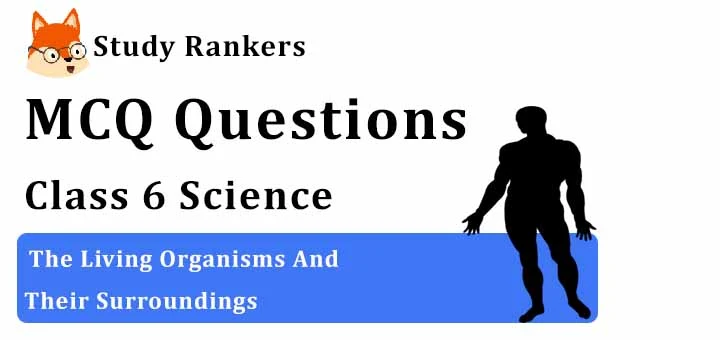MCQ Questions for Class 6 Science: Ch 9 The Living Organisms And Their Surroundings

1. The process of producing energy by the break down of food is called ______________
(a) Photosynthesis
(b) Transpiration
(c) Respiration
(d) Reproduction
► (c) Respiration
2. Bacteria and fungus are examples for ____________
(a) Producers
(b) Consumers
(c) Decomposers
(d) None of these
► (c) Decomposers
3. Which statements are true about the tree in hilly areas?
(a) These trees are normally cone shaped.
(b) They have sloping branches.
(c) The leaves of some of these trees are needle-like.
(d) All of the above.
► (d) All of the above.
4. Science of study of living things is called ___________
(a) Botany
(b) Biology
(c) Zoology
(d) None of these
► (b) Biology
5. Some animals hibernate to
(a) Escape cold weather
(b) Escape hot weather
(c) Preventing loss of water from body
(d) Escaping from enemies
► (a) Escape cold weather
6. Which part of a camel will shrink in size when there is no food for a long time and retain its size when food is available?
(a) Rough tongue
(b) Long eyelashes
(c) Hump
(d) Neck
► (c) Hump
7. Dolphins and whales breathe through _____________
(a) Gills
(b) Skin
(c) Lungs
(d) Blowholes
► (d) Blowholes
8. Environment consists of which of the following things?
(a) Only biotic environment.
(b) Only abiotic environment.
(c) Both biotic and abiotic environment.
(d) Only plants and animals.
► (c) Both biotic and abiotic environment.
9. Which characteristic of living things is also shown by a car?
(a) Response to changes.
(b) Need of energy.
(c) Reproduction of its kind.
(d) Taking in gases
► (b) Need of energy.
10. The place where living beings live is called their ______________
(a) Adaptation
(b) Habitat
(c) Habit
(d) Movement
► (b) Habitat
11. Anything which produce and response in an organism is called as ____________
(a) Life Cycle
(b) Adaptation
(c) Stimulus
(d) Growth
► (c) Stimulus
12. Which of these 4 help polar bears adapt to live in extreme cold climate?
(a) White fur, fat below skin, keen sense of smell.
(b) Long tail, blunt claws, thin skin, paws.
(c) White body, paws for swimming, gills for respiration.
(d) Thin skin, large eyes, white fur.
► (a) White fur, fat below skin, keen sense of smell.
13. In Cactus plant, _____________ are reduced to spines
(a) Leaves
(b) Flowers
(c) roots
(d) Stem
► (a) Leaves
14. Which is the major component of the living environment?
(a) Water
(b) Soil
(c) Trees
(d) Ponds
► (c) Trees
15. A microscopic plant which can move in water is _____________
(a) Sea-nemone
(b) Sponge
(c) Celotropis
(d) Chlamydomonas
► (d) Chlamydomonas
16. Which adaptation helps the camel to survive in hot and dry desert?
(a) It has a layer of fat under its skin.
(b) It sleeps during the day and is active at night.
(c) It stores fat in its hump which can be broken down when it need energy.
(d) It stores water in its long neck.
► (c) It stores fat in its hump which can be broken down when it need energy.
17. Organisms that obtain their food from others are called
(a) Producers
(b) Scavengers
(c) Autotrophs
(d) Heterotrophs
► (d) Heterotrophs
18. Buffaloes are often found near ponds because
(a) They breath only in the pond
(b) They cool themselves in the pond
(c) They like to play in water
(d) None of the above
► (b) They cool themselves in the pond
19. Which option is related to the function of scaly skin of snakes?
(a) To protect them from drying.
(b) To scare human beings.
(c) To make them beautiful.
(d) To help them to crawl.
► (d) To help them to crawl.
20. Wind dispersed seeds have __________
(a) Wings & Hair
(b) Hooks
(c) Fibrous outercoat
(d) None of the above
► (a) Wings & Hair
21. Life cycle of a living organism begins with _____________
(a) Birth
(b) Growth
(c) Death
(d) Reproduction
► (a) Birth
22. Which organism depends on abiotic components for food?
(a) Insects
(b) Birds
(c) Plants
(d) Fish
► (c) Plants
23. Global warming increases the concentration of ___________ in the atmosphere
(a) Oxygen
(b) Nitrogen
(c) Carbon dioxide
(d) Hydrogen
► (c) Carbon dioxide
24. An example for unicellular organism is ___________
(a) Yeast
(b) Mango Plant
(c) Dog
(d) Men
► (a) Yeast
25. In which habitat, can the animals move fast?
(a) Mountains
(b) Desert
(c) Grassland
(d) Forest
► (c) Grassland
26. Plant waste given out in the form of thick fluid is called as ___________________
(a) Gum
(b) Urine
(c) Latex
(d) Sweat
► (c) Latex

